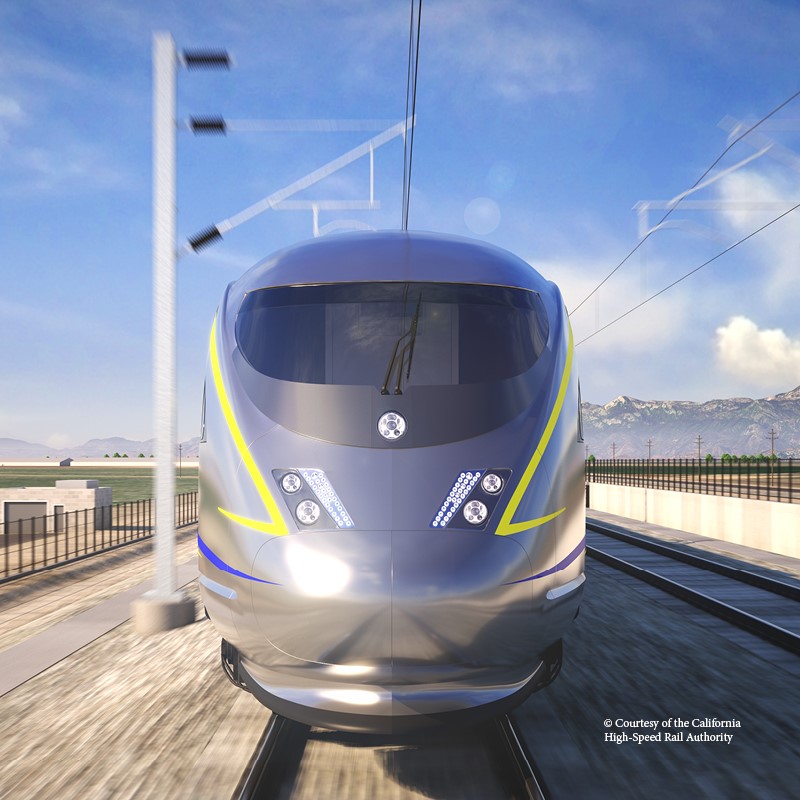In his May budget revision for fiscal year 2025-26, which began on July 1, Gov. Gavin Newsom earmarked $1 billion a year for the next 20 years from the state’s cap-and-trade system toward the rail project. Like the wounded Black Knight in the “Tis but a scratch scene” in “Monty Python and the Holy Grail,” the HSR is wounded to death but keeps hopping around.
Back in February, Secretary of Transportation Sean Duffy held a press conference at Union Station in Los Angeles and announced of the Federal Railroad Administration: “I will direct the FRA to do a compliance review—to assess the Bakersfield construction. We will look at whether the California High-Speed Rail project has actually complied with the agreements with the federal government.”
Released this month, the review found the project in default of federal grants, as it identified “a trail of project delays, mismanagement, waste and skyrocketing costs,” per the agency’s statement. “The project has received approximately $6.9 billion in federal dollars in roughly fifteen years but has not laid a single high-speed track.”
As part of the report, the administration also announced its plan to eliminate those $4 billion in subsidies. “Even if the state can eventually win a legal challenge or a future president elects to restore the money, the project, already plagued with delays and funding shortages, is facing one of the most serious setbacks in its 17-year history,” The New York Times reported.
California’s two U.S. senators, Alex Padilla and Adam Schiff, called the decision “devastating” for the state’s future transportation systems, but that’s a stretch. The major problem always has been the huge, sparsely populated area between the major population centers in Southern California and the Bay Area. The Golden State’s population density is 251.3 people per square mile, compared to 380.7 for China and 854.7 for Japan, two countries often cited as HSR models.
Killing HSR will not “have a major effect on California cities,” Baruch Feigenbaum told me; he’s is the senior managing director of transportation policy at Los Angeles-based Reason Foundation. Indeed, he said, “I see the main effects as positive.”
The California High-Speed Rail Authority, which runs the project, has boasted of “more than 14,500 construction jobs created.” Actually, Feigenbaum said, these jobs largely are in industries supporting the project, such as concrete. The companies “would have simply made concrete for a different project.” Other workers would have found jobs doing something else in a time of low unemployment, he said.
California’s unemployment rate for last April was 5.3%, the second highest of any state after Nevada’s 5.6%, and well above the national rate of 4.2%. But historically that’s still relatively low. And he pointed out the frequency of trains would not be high enough to generate many jobs at or near stations.
The HSR’s likely cancellation also means cities also will be avoiding the massive disruption already experienced along the Central Valley route. Using eminent domain, the project rips up cities and farms, causing chaos for little gain. On February 21, Benjamin M. Belnap, the HSR’s Inspector General, issued a review titled, “Pre-Construction Activities for the Merced and Bakersfield Extensions: Persistent Delays in Securing Agreements with Third Parties Require New Solution.”
Here’s the key sentence: “When the Authority began construction on the initial 119-mile section of guideway in the Central Valley (initial segment), it had not completed necessary early works.” That is, it didn’t work with local cities, businesses and citizens, as well as the California Coastal Commission and other regulators, to get ready to grab the properties. “Consequently, the initial segment has encountered significant schedule delays and cost increases caused by prolonged disagreements with third parties.”
Belnap found the HSRA has “implemented new product management procedures.” But it seems unlikely much will be done before the project is shut down. “HSR requires grade separation of tracks from cross streets, which will close off some neighborhoods from each other, and may fracture communities,” Feigenbaum added.
This is not a minor matter. When the Interstate Highway System was built starting in the late 1950s, it often cut through old neighborhoods in cities, usually those where the poor and unrepresented lived. In 2022, the U.S. Department of Transportation granted $104.6 million to dismantle one mile of the I-375 Interstate in Detroit that carved through a neighborhood, displaced 100,000 residents and contributed to the racial tensions that led to the deadly 1967 riots. Similar destruction divided major cities across the United States.
Feigenbaum also pointed out how HSR projects in Asia and Europe have been built around existing rail stations. By contrast, people here prefer flying for long distances, and their cars to walking. The increasing popularity of autonomous vehicles also is making HSR less viable. A 2021 study in IOP Science found AVs “are expected to compete with mass transit systems resulting in a decrease in transit users.”
The study looked at subways and bus systems, not HSR. But another perspective comes from Vinod Khosla, the founder of Khosla Ventures, a venture capital firm that has invested in DoorDash and other companies. Last October in the Financial Times, he pointed out, “Public transport systems like trains (light and heavy rail) are expensive to expand and inefficient when they are not full.”
Instead, he touted personal rapid transit systems that “can travel along narrow, dedicated pathways closed off to all other forms of transport and passengers can get on and off them anywhere they choose.” The pathways would be dedicated to the PRTSs and shut off to all other traffic. He says that’s more ambitious than existing electric AV systems such as Alphabet/Google’s Waymo, already operational in Los Angeles and San Francisco; or Tesla’s entry, expected for June in Texas, then later this year in California.
It’s clear the future of transit innovation in California is not HSR, a 19th-century technology, but airports connected by AVs. Although the waste has been immense for what’s also called the bullet train, many California cities are dodging a bullet.
John Seiler is on the Editorial Board of the Southern California News Group
(Image credit: California High Speed Rail Authority)

